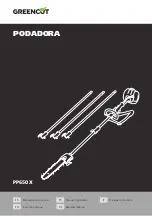
25
CUTTING AIDS AND ACCESSORIES (CONTINUED)
FEATHERBOARD
CUT OFF GAUGE
JIGS
When crosscutting a number of pieces to the same
length, you can clamp a block of wood (A) (See Figure
31) to the fence and use it as a cut-off gauge. The block
(A) must be at least 3/4-inch (19 mm) thick to prevent
the cut off piece from binding between the blade
and the fence. Once the cut-off length is determined,
lock the fence and use the miter gauge to feed the
workpiece into the blade.
Always position the entire cut-off
gauge in front of the saw blade.
FIG. 30
FIG. 31
Featherboards are used to keep the workpiece in
contact with the fence and table (Figure 30), and help
prevent kickback. Featherboards are especially useful
when ripping small workpieces and for completing
non-through cuts. The end is angled with a series of
narrow slots to give a friction hold on the workpiece, It
is locked in place on the table or fence with a c-clamp.
To avoid binding between the
workpiece and the blade, make
sure a horizontal feather board presses only on
the uncut portion of the workpiece in front of the
blade.
Dimensions for making a typical featherboard are
shown in Figure 30. Make your featherboard from a
straight piece of wood that is free of knots and cracks.
Clamp featherboards to the fence and/or table so that
the featherboard will hold the workpiece against the
fence or table.
1. Select a solid piece of lumber approximately
¾-inch thick, 2 ½-inches wide and 12-inches long.
2. Mark the center width on one end of stock. Miter
width to 70° (see miter cut section for information
on miter cuts).
3. Set rip fence to allow approximately a 1/4-inch
“finger” to be cut in the stock.
4. Feed stock only to mark previously made at 6
inches.
5. Turn saw off and allow blade to completely stop
rotating before removing stock.
6. Reset rip fence and cut spaced rips into workpiece
to allow approximately 1/4-inch fingers and 1/8-
inch spaces between fingers.
Jigs may be created with a variety of special set-ups
to control particular workpiece shapes for particular
cuts. Guidance on how to make specialized jigs can
be found in woodworking and carpentry websites and
publications.
Do not attempt to create or use a jig
unless you are thoroughly familiar
with table saw safety. Do not use any jig that could
result in pinching a kerf or jamming the workpiece
between the jig and the blade. Incorrect setups
may cause kickback which could result in serious
injury.
A
Содержание PCX362010
Страница 31: ...31 NOTES ...








































